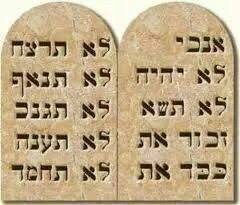The Ten Commandments
20: 3-17

Compared with Suzerainty Treaties, the Torah also had general conditions more commonly known as the Ten Commandments, or in Hebrew literally the Ten Words. They are also explained in Deuteronomy 4:44 to 11:32, and Joshua 24:14-15 and 23.
The Ten Commandments continue to stir controversy in both the community of believers and society. Some would question their relevance in public life today. Militant groups battle to remove them from schoolrooms, courtrooms and government offices, confining them instead to the area of private religion. More disturbing is the extent to which teaching the Ten Commandments in the Church has been replaced by the widespread heresy of antinomianism, or the idea that all one has to do is to try one’s best to be saved, and that the Ten Commandments should be ignored.362
Yeshua said to His disciples: Come, follow Me (Matthew 4:19). Following Jesus involves keeping the commandments of ADONAI. He said: Whoever has My commandments and obeys them, he is the one who loves Me. He who loves Me will be loved by My Father, and I too will love him and show Myself to him (John 14:21). Not only that, but the coming of the Messiah, did not do away with the Ten Commandments. Jesus taught: Do not think that I have come to abolish the Torah or the Prophets; I have not come to abolish them but to fulfill them (Matthew 5:17).
Therefore, for believers, what is the purpose of the Ten Commandments today? First of all, they are not a set of rules. Rules cannot bring freedom, they can only accuse. What they do accomplish is to reveal the heart of God, and thus are an indispensable part of the life of a believer. They have nothing to do with our justification, but they have everything to do with our sanctification. Justification is a one-time action by the LORD whereby, negatively, He forgives the sins of believers and, positively, He declares them righteous by imputing the obedience and righteousness of Christ to them through faith (Genesis 15:6; Psalm 32:2; Jeremiah 23:6; Romans 3:28 to 4:6; Gal 2:16, 3:8-9, 21, 24). Sanctification, however, is to be set apart, specifically, to the holy use and purpose of God. It takes work, and is a continuous lifetime struggle to be transformed into the likeness of Christ (Second Corinthians 3:18; Romans 12:1-2). It is a goal, and in reality, is never accomplished during our lifetime (see Perfectionism by B.B. Warfield). The result of being transformed is inward peace (Isaiah 32:17), observable spiritual fruit (Second Corinthians 9:8; Second Peter 1:5-11), and a deep desire to honor ADONAI (Matthew 5-16; John 15:8).
The Ten Commandments reveal the heart of God in three ways. First, the Torah is still a moral guide by revealing sin (Romans 7:7). Secondly, we know that all Scripture is God-breathed and is useful for teaching, rebuking, correcting and training in righteousness (Second Timothy 3:16). Therefore, the Torah can be used as a teaching tool to show ADONAI’s standard of righteousness, so that we can know Him better and love Him more. And thirdly, it can also be used to point others to Yeshua (Galatians 3:24-25). Nine of these Ten Commandments are also found in the New Covenant with conditions of the heart added that make us even more accountable not only in our actions, but in our thoughts as well. You could say they are God’s blueprint for living.



Leave A Comment